Accelerating Page Speed: Enhancing SEO and User Experience
Introduction:
In the world of technical SEO, page speed optimization stands tall as a critical factor that directly influences both user experience and search engine rankings. Slow-loading web pages can be frustrating for users and can negatively impact your website’s visibility in search results. In this article, we will delve into the importance of page speed optimization in technical SEO and explore key strategies to enhance your website’s performance.
Search Engine Rankings:
Search engines, including Google, consider page speed as a ranking factor. Websites with faster-loading pages tend to rank higher in search results, as search engines aim to deliver the best possible user experience. By optimizing your page speed, you can gain a competitive edge and improve your visibility in search engine rankings.
Key Strategies for Page Speed Optimization:
To optimize your website’s page speed, consider implementing the following strategies:
Image Compression: Optimize your images by compressing them without compromising quality. Large image files can significantly slow down page load times. Utilize image compression tools or plugins to reduce file sizes and improve loading speed.
Caching: Implement browser caching to store static resources, such as CSS, JavaScript files, and images, on the user’s device. This way, returning visitors don’t have to re-download these resources, resulting in faster page loading times.
Minification of CSS and JavaScript: Minify your CSS and JavaScript files by removing unnecessary characters, spaces, and line breaks. This reduces file sizes, leading to faster loading times. Tools and plugins are available to automate this process.
Content Delivery Networks (CDNs): Leverage content delivery networks to distribute your website’s static resources across multiple servers worldwide. CDNs store cached versions of your website closer to the user, reducing the distance data needs to travel and enhancing page loading speed.
Regular Monitoring and Testing:
Page speed optimization is an ongoing process that requires continuous monitoring and testing. Use tools like Google PageSpeed Insights, GTmetrix, or Pingdom to assess your website’s performance and identify areas for improvement. Regularly monitor your website’s speed metrics, such as time to first byte (TTFB), first contentful paint (FCP), and time to interactive (TTI), and make adjustments as needed.
Enhanced User Experience:
In an era where attention spans are shorter than ever, users expect instantaneous access to information. Slow-loading pages lead to frustration and increased bounce rates. On the other hand, fast-loading pages provide a seamless browsing experience, captivating users and encouraging them to explore further.
Search Engine Rankings:
Search engines, including Google, prioritize delivering the best user experience. They consider page speed as a crucial ranking factor, favoring fast-loading websites in search results. By optimizing your website’s page speed, you improve the chances of ranking higher, attracting more organic traffic, and ultimately increasing conversions.

